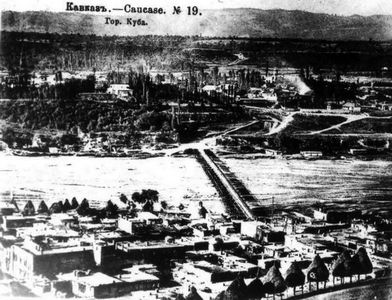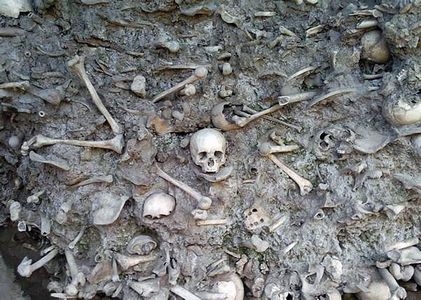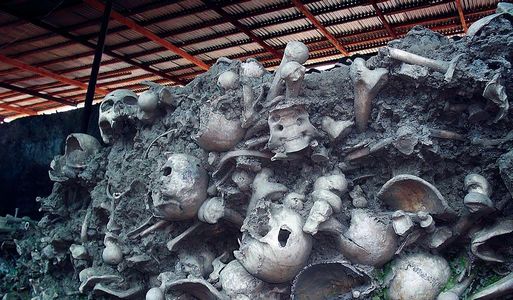Genocide of Azerbaijanis in Guba in March of 1918
Leaders of Armenian-Bolshevik of Baku Soviet have decided to extend the authority over Guba uyezd after the massacres in Baku and Shamakhi. At this time the troops which were comprised of the soldiers from Guba, under the leadership of Ali Bey Ziziksk were fighting in the region of Khirdalan and was aiming to save the lives of Muslim population of Baku. Therefore, the Soviet detachment of David Gelovani with a group of 187 soldiers entered Guba, and on April 23, declared Soviet power in the city. A group of 150 soldiers comprised of exclusevily Armenians led by Aghajanian entered Guba with 2 cannons. The detachment killed some inhabitants of Guba and began to burn houses in many streets, Uyezd administration, the City Duma and the Global Division. As a result of clashes with Lezghian troops that arrived from Dagestan in order to help Azerbaijanis, the detachments led by Gelovani and Aghajanian left the town.
On May 1, 1918 the troop led by Amazasp with two thousand of soldiers exclusively comprised of Armenians entered the town from three directions; afterwards, they surrounded the town and began to fire with cannons, machine guns and rifles. On the first day there were killed 715 Muslims in the lower part of the city, most of them were women and children. On the second day in the 1st and 2nd part of the town were killed 1,012 people, mostly men from the lower class of society and Persian civilians. Dead bodies remained in the streets for 9 days before the Armenians had left.
Upon arrival in Guba on the fourth day, Amazasp addressed to the residents of Guba who gathered around the Juma mosque: “We were ordered to annihilate all Muslims from the coast of the Sea (Caspian) to Shah-Dag, as it had been elaborated in Shirvan (Shamakhi), and to destroy your houses to the ground in retaliation for the killed by you and the Turks our brothers- the Armenians”.
Head of the town Aliabbas Bey Alibeyov having left for Baku, met with Shaumian who testified later: “Shaumian listened to me with a smile on his face and said that Muslims and Turks killed hundreds of thousands of Armenians, and when the Armenians killed two Muslims in Guba, the Muslims began to complain and shed tears”. D.Gelovani also named Shaumian, as the initiator of sending of punitive detachment to Guba: “In the detachment of Amazasp there were no Russians among the Armenians, it was comprised exclusively of the Armenians, the Dashnaks. Amazasp was a violent Dashnak. I suppose that the punitive detachment was sent to Guba in accordance with Shaumian’s desire”.
Only on the 9th day of Guba massacre the detachment led by Amazasp left the town, taking away 4 million rubles, gold, gold items and precious stones at 4.5 million, different goods and victuals at 25 million rubles.
In the early of 1918, Guba uyezd had 540 villages with population of 171,248 people. From late April to mid-May 1918, a minimum of 167 villages in the uyezd were burned and demolished by Amazasp’s detachment, moreover without considering those villages where the Armenians had plundered and looted the property. Volunteer detachments of Guba residents under the leadership of A.Ziziksk and other distinguished representatives led heavy fighting, trying to prevent the Armenians enter other large settlements of the uyezd.
Furthermore, the main target of Bolshevik-Dashnak forces were all Muslim population of the uyezd, and other ethnic groups became their victims as well. From hearsay, not only Azerbaijani, but also Lezgian, Tat villages were ruined and burned. In the ravine between the villages Digah and Khuchbala a large group of Gusar Lezghins were killed by the Armenians, as a result of which this place was called “Bloody ravine”. Red Commissioner Kasradze wrote: “Returning from Khachmaz, we had witnessed the panic escape of Jewish masses from Guba and other villages. They were bare, exhausted and huddled in the open air, in the mud and unwittingly became the centre of epidemic typhus, smallpox and other diseases”.
According to different sources and witnesses’ testimonies during the massacre in Guba the death toll included approximetly 2, 000 up to 2,900 people in the town, and in total over 4,000 thousand of people were killed in Guba uyezd.
Armenian-Bolshevik regime has sought to conceal its repeated crimes of the Guba massacre. Therefore, the witness of the slaughter D.Gelovani was killed by Armenian terrorist Sarkis Terunts at the end of October in 1919. Amazasp was killed in Yerevan jail, in February of 1921.
According to the records of Extraordinary Investigation Commision prepared in 1918-1919 including a number of documents and witnesses’ testimonies, as well as the discovery of mass grave sites in Guba in 2007, confirmed that the people buried there had been tortured and proved to be the result of the 1918 genocide against Muslim population.


